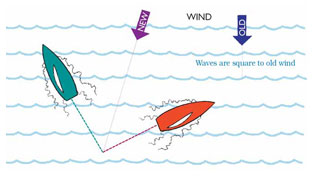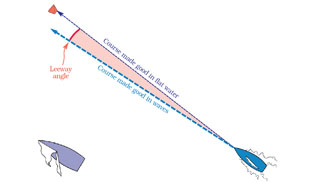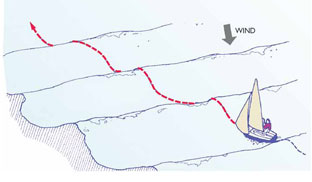|
Key wave concepts
by David Dellenbaugh
Waves are like snowflakes. No two
are exactly the same, and therefore
you have to treat each one as a unique and
different entity. The same is true in the
big picture—every sequence of waves
you face during a race will be at least a
little different from anything you have
ever seen before. So you must continually
work at finding the optimal path
through the waves you face.
When you get to the race course, it is
helpful to ask a few questions to understand
the waves and how they will affect
your race:
• What's causing the waves? The size
and shape of waves will depend on
whether they are caused by wind, current
or boats. You could have smooth swells
from a storm far away, steep chop when a
strong breeze blows over shallow water
or when current flows against the wind,
or random chop from motorboats in a
spectator fleet.
• Are the waves the normal size that
you would expect for the wind velocity? For various reasons, the waves might be
larger or smaller than normal (see below).
This could have huge implications for
steering, trimming and sailing the boat.
• Are the waves perpendicular to the
wind direction? If the waves are flowing
in the same direction as the wind, then
you will generally have symmetry from
tack to tack. But If not, you will need to
set things up differently on each tack.
• Are you going faster or slower than
the waves downwind? Figure out if the
waves are helping you (i.e. they're going
faster than you) or hurting you (you're
faster than them). Also, do surfing conditions
exist? This is key to knowing if you
are allowed to pump your sails. Here are
further explanations of some of these
concepts.
 Check for wave asymmetry
Check for wave asymmetry
When you're racing upwind, are the waves equal on each tack? They are usually similar on port and
starboard tacks because waves are created by the wind and therefore they come from that direction.
However, this is not always the case. Sometimes the waves are not perpendicular to the wind, and
this can have a huge impact on the way you sail your boat.
There are several reasons why waves may be different from tack to tack:
• Windshifts - If the waves are at first aligned with the wind, any change in wind direction will
make them unaligned (at least for a while).This is very common.
• Presence of nearby land - If there is land to windward of the course, it could affect how waves
move across the racing area.
• A distant storm -When you're racing on the ocean, there are often swells coming from a direction
that's very different from your sailing wind.
• Cross-current - If you have a strong current that is not aligned with the wind, it often creates
waves that aren't square to the wind.
When you first start sailing in your race area, check to see if the waves are the same on each
tack. If not, make the appropriate sail trim adjustments. For example, you will have to make your sails
fuller and more twisted on the bumpier tack (which goes more directly into the waves). On the other
(smoother) tack you may be able to trim your sails much flatter and tighter. You can point higher on
this tack, too, and keep your weight a little farther forward.
There are also strategic implications of wave asymmetry. For example, if port tack is smoother
it might mean the wind has shifted to the right. When wave asymmetry is caused by a persistent
windshift, it's better to sail the smoother tack first since that will take you in the direction where the
wind is shifting.
Motorboat waves
It would be hard to run most sailboat races
without motorboats, but it sure would be nice if
we could run them without motorboat wakes!
Unfortunately, waves from motorboats are a
fact of life in most racing venues, and the good
sailors simply figure out how to handle them.
Motorboat waves differ from wind generated
waves in several important ways. They are
often steeper and closer together (and therefore
can potentially hurt your speed much more).
Boat waves typically hit you at strange angles
(rather than straight with the wind). And, fortunately,
they usually come and go pretty quickly.
The first rule for maintaining speed
through waves is to hit them at an angle
(instead of head on).This is normally worth
doing even if it requires a significant alteration in
the course you have been sailing. In fact, it may
even make sense to tack or jibe so big waves
hit your stern rather than your bow.
The second rule of thumb for motorboat
waves is to make sure you are going fast just
before you hit them. In other words, be proactive
by bearing off (or heading up on a run),
easing (or trimming) your sails, moving weight
aft, etc. Don't wait until the first wave hits you
before making these changes!
As I mentioned above, you ideally want to
hit motorboat waves at an oblique angle and
fully powered up. But sometimes you can't do
both. When the waves are coming at you parallel
to the wind, you have to make a choice. It's
usually better to hit waves at an angle even if
you have to pinch up and lose a little speed.
This seems better than bearing off for speed
and hitting the waves head on.
Waves relative to wind
In any wind velocity, there is a certain size and
shape of waves that you normally see with that
amount of wind. In a five-knot breeze, for
example, the water surface should be almost
totally flat. In 18 knots of wind, however, you
expect to see fairly good-sized waves with
whitecaps.
But as every sailor knows, you don't
always get 'normal' sea conditions. You might
see bigger or smaller waves than what's typical
for that wind velocity, and this will affect how
you set up and sail your boat.
When I'm racing, I categorize the wave
state in three general ways:
1) Normal waves for the wind; 2) More
wind than waves; and 3) More waves than
wind. Here's a closer look at each.
'More wind than waves'
This is almost always a fun condition for sailing
(unless you're trying to do a windy jibe). It's
great (or painting and speed, and makes staying
in the 'groove' pretty easy.
Here are several times when you are likely
to see this condition:
• A building breeze—the breeze is up but
the waves haven't had time to build yet
• An offshore breeze—the water is flatter
as you get closer to land because there is less
'fetch' for the waves to build.
• Current flowing with the wind.
When you have more wind than waves,
you can trim your sails flatter and harder than
you normally would in that breeze. You should
sail most boats as flat as possible and go for
maximum height (pointing).
'More waves than wind'
This is almost always a tough condition for sailing
(unless you are sailing downwind with
enough breeze to surf). It makes finding the
groove difficult, and it quickly separates the
good sailors from the rest.
You will typically see this condition with:
• A dying breeze—the breeze always
changes faster than the wave state.
• An onshore breeze—when the wind is
blowing toward the shore, it usually has a long
'fetch' for the waves to build.
• Current flowing against the wind.
• Lots of motorboat wakes (the worst!).
When you have more waves than wind, be
careful about trimming too hard or pointing too
high. Err on the side of twist, power and footing
so you keep going fast
 Watch for leeway caused by waves
Watch for leeway caused by waves
Waves make sailboats go up and down, and they also push boats to leeward.
The difference between the course you steer and the course you make good
through the water is your leeway angle. The size of this angle is a result of
many factors such as heel angle, wind velocity, boat design and wave
height. Though leeway for racing boats is usually not more than a few
degrees, it will get slightly larger as the waves get bigger.
The main place where you will notice leeway is in relation
to fixed objects like marks. Your laylines are wider, for
example, in waves, so you must allow a little extra
distance before tacking.
One place where it's easy
to see how much the waves push
you to leeward is at the starting line.
When boats attempt to luff in place on the line,
they often slide much farther to leeward than
they think. That's one reason why there
is often a significant line sag when the
waves are big.
Go fast upwind
in waves
Except for those few times when you
are able to ride a motorboat wake
coming from behind, waves are never
helpful when you're racing upwind. It's
always faster to sail in flatter water, and
that should be your first rule of thumb
on beats.
Sailing fast in waves requires a
team effort that involves the driver.
trimmers and the rest of the crew. You
have to look ahead for waves that are
coming, shift gears and find the best
way to steer through them.
There are three basic strategies for
dealing with waves upwind. You can
sail directly through the waves, steer
over the waves, or try to avoid the
waves. More likely, you will do some
combination of the above.
Going straight through waves is
usually the best option when the waves
are everywhere and too small to steer
around. The bigger and heavier your
boat, the more likely you are to take
this approach since it's often impossible
or slow to turn your rudder for individual
waves.
This is not a great option for bigger
waves, but sometimes it is your only
choice (e.g. when all the waves are big
and steep!). In that case, try to keep the
boat going a little faster than usual up
the beat. The most costly mistake is to
be too slow when you hit a bad wave.
Anticipation is important. The key
to maintaining speed through bad
waves is to shift gears before you get to
them. That means you need enough
warning to power up your sail plan
before the bow digs into the first wave.
Steering over the waves is a good
idea when they are larger and spaced
farther apart, and when going straight
through them is slow. The smaller and
lighter your boat, the more effective
this is.
The basic technique for sailing
over waves is to head up on the front
side and bear off the back side. In other
words, luff toward the wind a little as
you go up the wave and then bear off
away from the wind as you go down the
back side. The steeper the wave and the
faster your speed over the waves, the
more sharply you will have to turn your
helm and your boat.
In boats that are light enough to be
affected by the positioning of crew
weight, combine the steering with a
rotational movement of your bodies:
Lean aft (and maybe in a little) as you
go up the wave. Then lean out and forward
as you go over the top and down
the back side.
Avoiding waves is always the preferred
option. This works well when
you have identifiable areas of bad
waves, such as boat wakes or sets of
especially large, steep waves. Since
you can never avoid all waves, you
must use this in concert with other
ways to sail through waves but this
strategy should always be a part of your
upwind plan.
The techniques that work best in
waves are often subtle enough that you
never know how well they are working
until you measure your performance
against nearby boats. So test your wave
strategy before the start and continue to
evaluate it during the race. If you're not
fast, change something and try again!
Put your weight in the right places
One of the reasons why waves make a boat go
more slowly is because they cause it to 'hobbyhorse,'
which disrupts the air flow around its
sails and the water flow around its foils. This is
especially harmful in lighter air.
The main goal of positioning your weight
in waves, therefore, should be to reduce hobbyhorsing.
Keep your crew together as much as
possible and near the middle of the boat. In light
air, the ideal spot is right at the top of the keel,
since that is the point around which the sail
plan, hull and foils pivot. When conditions are
bumpy and light, it's not unusual for crews to sit
down below on the cabin sole (in bigger boats)
or to crouch down inside the cockpit (onedesigns).
This reduces the range of motion of
the mast and keel/centerboard.
In heavy air the crew can't be inside the
boat, of course. Instead they should sit tightly
together like the crew on the boat above. The
fore-and-aft position of their weight depends on
the boat, wind strength and wave shape.
Generally, the crew should be at least slightly
farther aft when it's rough (than when it's flat
with the same wind velocity) to keep the bow
from plowing into waves.
If you're racing upwind in waves and you
think your weight is positioned perfectly but you
aren't going fast, try moving your crew a little
farther apart. Sometimes the boat doesn't 'click'
with the natural frequency of the waves—but
different crew spacing may improve this harmony
(and therefore your speed!).
How much to steer in waves!
When you're sailing upwind, waves will
always slow you down, so you should avoid
them as much as possible (see below).
However, when you turn your rudder to steer
around waves, the drag you create will also
make you go slower. Therefore, you are always
searching for the optimal tradeoff between
using a lot of rudder and missing waves versus
using less rudder and hitting waves.
The only true way to judge whether you
are doing a good (fast) job of this is by comparing
your performance to that of a nearby
boat. That's why it's critical, when you have
waves, to train with another boat if possible and
to tune up with a competitor before every race.
While you are doing this, try different steering
techniques to see what is fastest in the unique
conditions that you have on any day.
The last thing you
want to do in a
wavy race is
to be looking
for
the groove as you come off the starting line.
Several factors influence the tradeoff of
how aggressively you should steer (i.e. how
quickly and how far you should turn the rudder).
Here are two important considerations:
• Size and shape of the waves - Are the
waves big, small, rounded or crested? How
steep and close together are they? You don't
have to steer much in small waves or even big
swells, but medium-size waves can present a
tough challenge, especially when they're steep
and/or close together,
• Characteristics of your boat - Is your
boat large or small (relative to the waves), light
or heavy? Does it turn easily? Does it have a
narrow bow that cuts easily through the waves
or a fat bow that slams into waves? All these
factors affect the tradeoff of hitting a wave versus
turning to miss it.
One thing that's true for all boats and
waves is that when you turn the boat, it's best
to do this with as little rudder as possible.
Reduce drag by steering with sail trim and body
weight. For example, use windward helm to
allow the boat to carve its own turn to windward
on the front of the wave. Then, at the top of the
wave, hike out hard and ease the mainsheet or
traveler to help bear off down the back side. If
you can turn the boat without so much drag,
then the tradeoff moves in the direction of steering
to miss more waves.
Dave publishes the newsletter
Speed & Smarts. For a subscription
call: 800-356-2200 or go to:
www.speedandsmarts.com

These waves are unusually large, uniform and rounded on top, so it's not necessary to
steer around them very much. The ideal course would be a gradual, slight arc to windward
on the approaching face of the wave, followed by a similar bearing off down the back side.
TOP
|